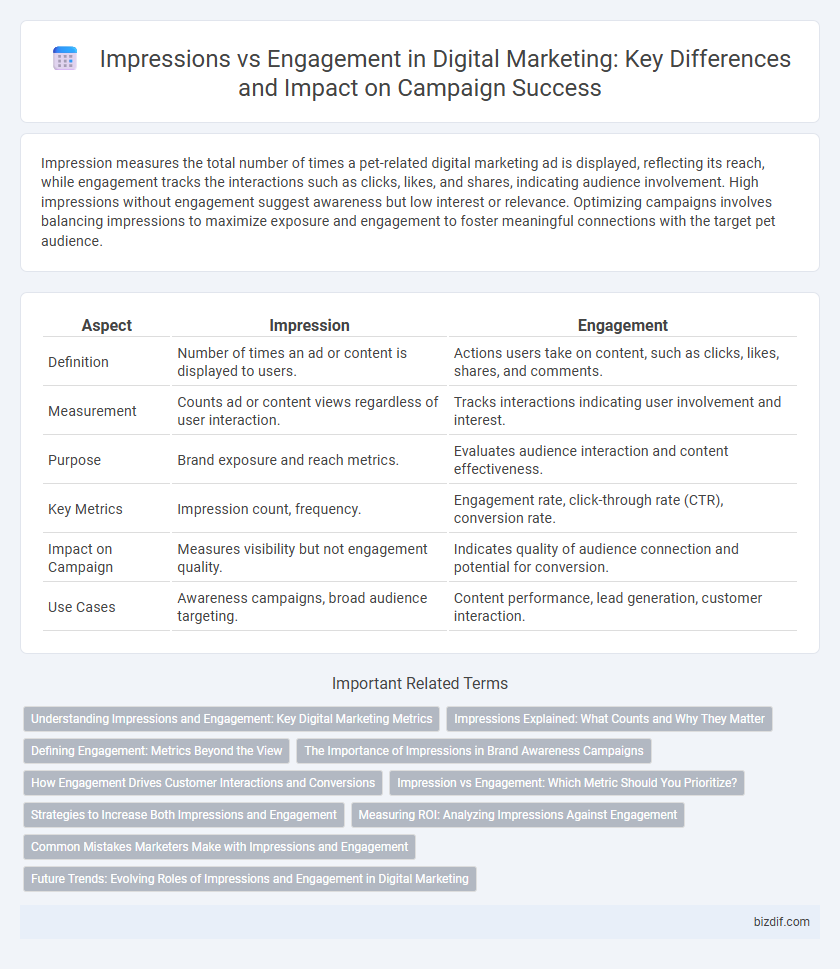Impression measures the total number of times a pet-related digital marketing ad is displayed, reflecting its reach, while engagement tracks the interactions such as clicks, likes, and shares, indicating audience involvement. High impressions without engagement suggest awareness but low interest or relevance. Optimizing campaigns involves balancing impressions to maximize exposure and engagement to foster meaningful connections with the target pet audience.
Table of Comparison
| Aspect | Impression | Engagement |
|---|---|---|
| Definition | Number of times an ad or content is displayed to users. | Actions users take on content, such as clicks, likes, shares, and comments. |
| Measurement | Counts ad or content views regardless of user interaction. | Tracks interactions indicating user involvement and interest. |
| Purpose | Brand exposure and reach metrics. | Evaluates audience interaction and content effectiveness. |
| Key Metrics | Impression count, frequency. | Engagement rate, click-through rate (CTR), conversion rate. |
| Impact on Campaign | Measures visibility but not engagement quality. | Indicates quality of audience connection and potential for conversion. |
| Use Cases | Awareness campaigns, broad audience targeting. | Content performance, lead generation, customer interaction. |
Understanding Impressions and Engagement: Key Digital Marketing Metrics
Impressions quantify how often a digital ad or content is displayed, reflecting potential visibility across platforms like social media and search engines. Engagement measures user interactions such as clicks, likes, shares, and comments, indicating the effectiveness and relevance of the content to the audience. Balancing impressions with engagement rates helps marketers optimize campaigns by targeting audiences that not only see but actively respond to their messaging.
Impressions Explained: What Counts and Why They Matter
Impressions represent the total number of times an ad or content is displayed on a user's screen, regardless of whether it is clicked or interacted with. They matter because they provide a metric for brand visibility and reach, helping marketers understand how often their message appears to the target audience. Tracking impressions enables optimization of ad placements and budgeting by assessing exposure levels across different platforms.
Defining Engagement: Metrics Beyond the View
Engagement in digital marketing measures user interaction with content, including clicks, likes, comments, and shares, providing deeper insight than mere impressions. Metrics such as time spent on page, video completions, and conversion rates reveal the quality and relevance of the audience's experience. Tracking these interactions enables marketers to optimize campaigns for meaningful connections rather than just visibility.
The Importance of Impressions in Brand Awareness Campaigns
Impressions measure the total number of times an ad is displayed, playing a crucial role in boosting brand visibility and recognition in digital marketing. High impression counts increase the chances of audience exposure, which is essential for establishing and reinforcing brand awareness during campaigns. While engagement reflects user interaction, impressions lay the foundation for widespread brand recall and long-term customer connection.
How Engagement Drives Customer Interactions and Conversions
Engagement in digital marketing represents active customer interactions such as clicks, shares, comments, and likes, signaling genuine interest beyond mere visibility measured by impressions. Higher engagement rates correlate with increased trust and stronger brand relationships, which directly influence conversion rates and customer loyalty. Tracking engagement metrics provides actionable insights to optimize campaigns, enhancing targeted communication and driving measurable business growth.
Impression vs Engagement: Which Metric Should You Prioritize?
Impressions measure the total number of times your ad or content is displayed, providing insight into brand visibility and reach, while engagement tracks user interactions such as likes, comments, shares, and clicks, reflecting audience interest and content effectiveness. Prioritizing engagement over impressions drives deeper connections and higher conversion potential, as engaged users are more likely to take action. For digital marketing success, focusing on engagement metrics allows for more precise optimization and improved return on investment (ROI).
Strategies to Increase Both Impressions and Engagement
To increase both impressions and engagement in digital marketing, optimize content with targeted keywords and visually compelling elements that resonate with the audience. Leverage data-driven ad placements and audience segmentation to enhance reach while encouraging interactions through interactive features like polls and calls-to-action. Consistently analyzing performance metrics enables refinement of strategies to maximize visibility and user participation effectively.
Measuring ROI: Analyzing Impressions Against Engagement
Measuring ROI in digital marketing requires analyzing impressions alongside engagement metrics to gauge campaign effectiveness accurately. While impressions quantify the number of times an ad is displayed, engagement measures interactions such as clicks, likes, shares, and comments that indicate audience interest and action. High impressions with low engagement may signal limited impact, whereas balanced engagement rates better reflect valuable customer connections and potential conversions.
Common Mistakes Marketers Make with Impressions and Engagement
Marketers often mistake high impressions for effective engagement, overlooking that impressions only measure how often content is seen, not interacted with. Failing to analyze engagement metrics like clicks, shares, and comments leads to inaccurate assessments of campaign performance. Ignoring the quality of engagement results in wasted budget and missed opportunities to connect with the target audience meaningfully.
Future Trends: Evolving Roles of Impressions and Engagement in Digital Marketing
Impression metrics will increasingly integrate advanced AI to measure not just visibility but viewer intent and emotional response, enhancing predictive targeting accuracy. Engagement will evolve beyond clicks and likes to include immersive interactions within AR and VR environments, driving deeper user involvement and personalized experiences. Combining these trends, digital marketers will harness multi-dimensional data to optimize campaigns in real time, aligning brand presence with meaningful consumer actions.
Impression vs Engagement Infographic

 bizdif.com
bizdif.com